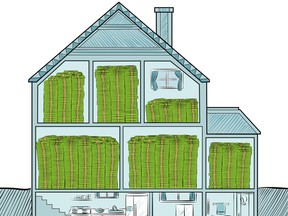As HELOCs are usually based on a variable interest rate, borrowers can expect a corresponding increase in required payments

Reviews and recommendations are unbiased and products are independently selected. Postmedia may earn an affiliate commission from purchases made through links on this page.
Article content
Despite expectations that the Bank of Canada was poised to increase interest rates this year, a 10-year record was broken when Canadians borrowed an additional $2 billion on home equity lines of credit (HELOC) in February 2022 — the highest one-month increase since 2012.
Advertisement 2
Article content
Before we discuss the ramifications of this, let’s first back up a bit and explain what a HELOC is and how it works. A HELOC is a line of credit secured to your house. It’s like a second mortgage that, once in place, costs you nothing if you don’t use it. Upon qualification, a homeowner can borrow up to 80 per cent of their property’s value, including any outstanding mortgages currently in place.
Article content
For example, if your house is worth $500,000 and you currently owe $300,000 against it, the remaining equity you could access via a HELOC is $100,000 ($500,000 x 80 per cent minus the $300,000 mortgage). If a homeowner doesn’t have a mortgage, then the maximum amount for a HELOC is 65 per cent of the home’s value.
The advantage of HELOCs is that a homeowner can access their equity anytime they choose, without having to repeatedly apply for financing for vehicles, home repairs and vacations. Payments are low, based on an interest-only amount, but, just like a credit card, it’s also a revolving form of credit. That means these lines of credit come with the risk of potentially never being fully paid off.
Advertisement 3
Article content
HELOCs are also usually at a variable interest rate, which means they are subject to interest-rate fluctuations. This isn’t a bad thing when rates are falling. But it can be a risky product in our current economic climate. Every time interest rates increase, so will the required payment on a HELOC.
Why then would so many Canadians choose to access their home’s equity in such uncertain times?
One reason could be that consumers are tapping into their newfound equity to consolidate other higher-interest debts. It’s not a bad decision to move high-interest debt to a lower cost of borrowing, but it can put your house at risk if rates continue to rise and payments become unaffordable.
Some Canadians may also have found themselves owing Canada Emergency Response Benefit (CERB) repayment at tax time and decided the best way to avoid Canada Revenue Agency’s imposed interest was to use their convenient, lower-interest HELOCs to pay it off.
Advertisement 4
Article content
Another possible cause could be that many homeowners are doing some much-needed work-at-home renovations. There’s nothing like being stuck at home for two years during a pandemic to realize your home is in need of upgrades.
As property values have increased over recent years, so has the amount of equity that can be partially accessed by way of a HELOC. Having a flexible borrowing option such as a HELOC means easy access to funds that can help improve your living space as well as your home’s resale value.
A HELOC can be a valuable borrowing tool as long as it is used correctly. However, access to credit on demand can make it far too easy to spend beyond what we may be capable of repaying. Even though using this credit to do renovations might increase your home’s overall value, it doesn’t mean you can afford to service that additional amount of debt.
Advertisement 5
Article content
How will the recent and impending interest rate hikes affect homeowners who already have debt owing on their HELOCs?
-

The rate hikes cometh: How to get your mortgage ahead of a rising rate environment
-

Faster rate hikes, cooling home prices could put the squeeze on HELOC holders
-

Possible downsides behind record increase in home equity lines of credit
-

How much do we owe against our homes? Not even the Bank of Canada knows for sure
As HELOCs are usually based on a variable interest rate, when the Bank of Canada raises its overnight rate, borrowers can expect to have a corresponding increase in required payments. Every $100,000 of HELOC debt owing results in an additional $500 of interest charged per year when interest rates increase by 0.5 percentage points.
Advertisement 6
Article content
If interest rates rise by a further one to 1.5 percentage points this year, the result will be an annual increase of $1,500 in interest, on top of what you were already paying. For Canadian households struggling with the increased cost of living, this may just be too much for their budgets to handle.
To escape potential variable interest-rate hikes, consider converting lines of credit to a fixed interest rate. Speak to your financial institution or mortgage lender to find out what your options are. Keep in mind that locking in will guarantee your interest rate, but the required payment amount will likely increase.
If an increased payment will put too much strain on your budget, you may find it useful to have a free financial review with a not-for-profit credit counselling agency. A credit counsellor can discuss ways to improve your household budget and free up room to pay down that outstanding debt.
Sandra Fry is a Winnipeg-based credit counsellor at Credit Counselling Society, a non-profit organization that has helped Canadians manage debt for more than 25 years.
_____________________________________________________________
If you like this story, sign up for the FP Investor Newsletter.
_____________________________________________________________
